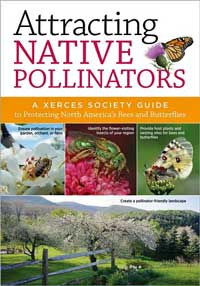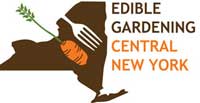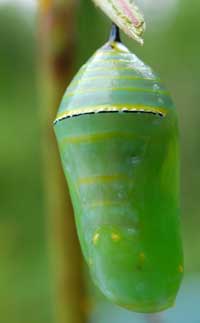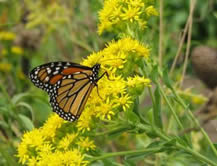Bringing Back the Pollinators Talk
Oct. 10
|
 | | Black is a co-author of this excellent book |
|
What we can all do to protect these essential creaturesElizabeth E. Rowley LectureDate: Oct. 10 at 7:30 pm Location: Cornell's Statler Hall Auditorium Speaker: Scott Black, Executive Director, The Xerces Society for Inverteberate Conservation; Chair of the International Union for Conservation of Nature Butterfly Specialist Group Black will discuss the importance of insect pollinators, outline the groups of insects that provide pollination services in North America, and present straightforward actions that each and every one of us can take to protect and provide habitat for pollinators. For more information ...
|
Project BudBurst
|
 | | When will the leaves turn color this year? |
|
This year's unseasonable, unreasonable weather is a good reminder for us to get out there in our landscapes and collect data on the life stages of plants: when they first leaf out all the way through to when the last leaves fall (and they may fall early this year). Help scientists get the information they need. Join Project BudBurst and become a citizen scientist! |
|
HGCNY Shopping Guide
 | |
(Click image to download)
|
To help you find native plants in CNY, we've compiled a list of plants offered by several local nurseries. REMEMBER, nurseries can sell out of any particular plant, so it's a good idea to call before setting out on your shopping trip! DOWNLOAD: This guide is available online as a free .pdf download. |
| Skaneateles Lake Watershed Events |  |
iMapInvasive Workshop Oct. 18, 7:00 pm - 8:30 pm Baldwinsville Public Library 33 E. Genesee St. Baldwinsville
For details and to register visit www.extendonondaga.org or contact Sherry Martin at 315.424.9485 ext. 232, sm674@cornell.edu |
| Our Habitat Garden |  |
Visit Our Habitat Garden website for information on providing habitat, earth-friendly gardening practices, plants, and various creatures here in Central New York.
|
|
Join HGCNY!
|  |
Becoming an official member of HGCNY is easy: just join Wild Ones! When you're a Wild Ones member, you're automatically an official member of HGCNY. |
| HGCNY on Facebook |
As as more of us participate on our Facebook page, this will become a useful resource for asking (and answering!) local HGCNYers' questions about habitat gardening. |
| Interested in Edible Gardening? | 
|
If you'd like to get information on Edible Gardening CNY, just email John to find out about edible gardening tours and monthly programs. Free and open to the public! |
|
Our Edible Garden: updated with GROUNDHOG info!
|  | Visit OurEdibleGarden.org to see an example of a Central New York edible garden, the perfect companion to your habitat garden.
Here's our experiences with groundhogs, and here's our solution to the groundhog problem!
|
|
Greetings!
 | Photo: Wikipedia CC
|
Our first program this year is something to hoot about!
Our first meeting this year is Sunday Sept. 30 at 2:00 pm at Liverpool Library.
Jean & Lenny Soprano of Kindred Kingdoms Wildlife Rehabilitation Inc. will introduce us to a live hawk and live owl at the library and will discuss their similarities and differences. Learn about wildlife rehabilitation and meet these birds of prey.
Mark your calendars for the last Sunday of the month for a year of terrific programs! They're free and open to the public.
~ Janet Allen
|
|
 | |
A monarch with a MonarchWatch tag
|
The migration begins
We were lucky to be able to enjoy monarchs this summer. Apparently, monarchs were more abundant in the Northeast than in other parts of the country.
Now their perilous journey to Mexico--up to 3,000 miles--begins. It will be a difficult one since drought along the way has led to fewer nectar resources to fuel their flight.
This year, Journey North reports more sightings of migrating monarchs along the Atlantic coast than in the central flyway, where they usually are more numerous.
This eastern flyway is more challenging, though, because of the longer distance, westerly winds, and the Atlantic Ocean and Gulf of Mexico.
Past recovery of tagged monarchs in Mexico indicates that fewer monarchs tagged on the east coast make it to Mexico -- roughly only 1 in 100! Read more from Journey North ...
Flapping or gliding?
Sometimes we see monarchs flapping and sometimes gliding. Which is more efficient?
Dr. David Gibo found out. A monarch with 140mg of fat could flap for only 44 hours, but could glide for 1,060 hours before running out of fuel.
Visiting England!But there can be too much wind. On Sept. 7 people in England discovered a monarch that apparently was blown off course by Hurricane Isaac.
|
 | |
Monarch chrysalis
|
What's going on in that chrysalis?
To see what's inside a monarch chrysalis, check out these CT scans of a day-old chrysalis and a 9-day-old chrysalis.
Fascinating!
See the CT scans ... |
 | |
Milkweed seedpod
|
Wild Ones partners with Bring Back the Monarchs
At the annual meeting, Wild Ones voted to partner with the Bring Back the Monarchs campaign.
Details are being worked out, but it will definitely involved milkweeds - planting them and collecting their seeds!
Of course, a contribution to the Bring Back the Monarchs campaign is also welcome.
|
 | | Planting milkweed seeds in a pot in fall |
Planting milkweed
According to Dr. Chip Taylor, director of Monarch Watch, the monarch population is only 50% of the long-term average, mainly due to loss of habitat.
Monarchs have lost around 160 million acres since the mid-1990s. In addition to that, changes in agriculture have led to eliminating milkweed from fields, a loss of about 100 million acres since 2000.
Read the whole article ...
Plant milkweed!
We can help make up for some of these losses by planting more milkweed.
Here's one easy way:
Simply sprinkle milkweed seeds in pots, sink them in the soil and let winter "cold-stratify" them for you. (Some sources suggest waiting until after frost.)
Don't forget to label the pot so you won't be wondering what's coming up in the spring.
More about growing milkweeds in Our Habitat Garden...
|
 | | Monarch nectaring on goldenrod |
Goldenrods
Those beautiful gold and purple fields of goldenrod and aster are extremely important as nectar sources as monarchs make their way to Mexico. Unfortunately, the myth persists that goldenrods cause allergies, so people are reluctant to plant these golden beauties. The important thing to know is that goldenrods are insect-pollinated and so have heavy, less-abundant pollen than plants that are wind-pollinated. And what plant is wind-pollinated? Ragweed! Since the nondescript ragweed often hangs out with showy goldenrod, the more noticeable goldenrod takes the blame as the ragweed spreads its massive load of pollen. Read more from Science Daily ...and see the goldenrods in Our Habitat Garden |
|
Share a photo of your Monarch Waystation
 | | Monarch Waystation sign |
If you have milkweeds, nectar plants, and refrain from using pesticides, you're helping monarch butterflies survive, and you may even have an official Monarch Waystation.
If you've met the Monarch Watch requirements for providing for the monarch's needs, you can become certified and are eligible to purchase a sign. (Note: Monarch Watch includes non-natives on their plant list, but we suggest natives instead!)
If you have a certified Waystation, send a digital photo, and we'll create a page on our HGCNY website showing the Monarch Waystations in CNY.
Please include your Waystation number and how you would like to be identified (e.g. "Syracuse," "Sam from Syracuse," "Sam Smith at 100 Main St., Syracuse," etc.--whatever level of specificity you're comfortable with).
You're also welcome to include a brief paragraph indicating what kind of milkweed and other native nectar plants are in your Waystation and any other information of interest.
Our first Waystation The Women's Garden Club of Baldwinsville submitted our first Monarch Waystation, Yevich Trail! |
|
|
|
|